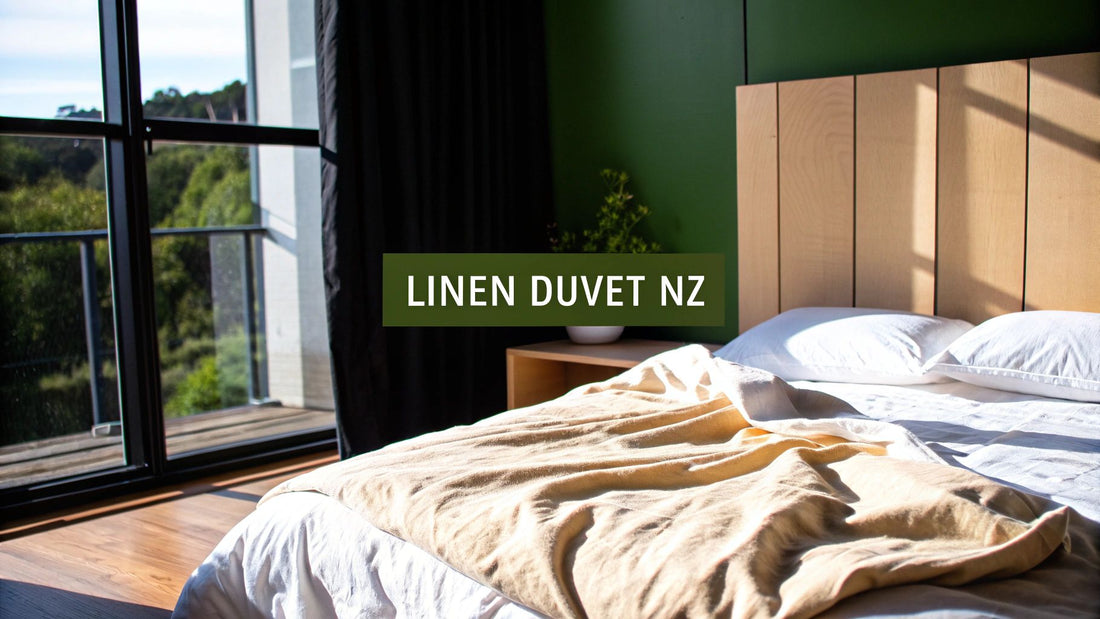Welcome to the world of linen, a fabric that brings a unique blend of casual elegance and natural comfort into New Zealand homes. If you've found yourself searching for linen duvet covers NZ, you're on the path to discovering bedding that offers genuine year-round comfort, incredible durability, and a style that simply never fades.
Think of this as your complete guide to making a choice you’ll be happy with for years to come.
Your Guide to Linen Bedding in New Zealand
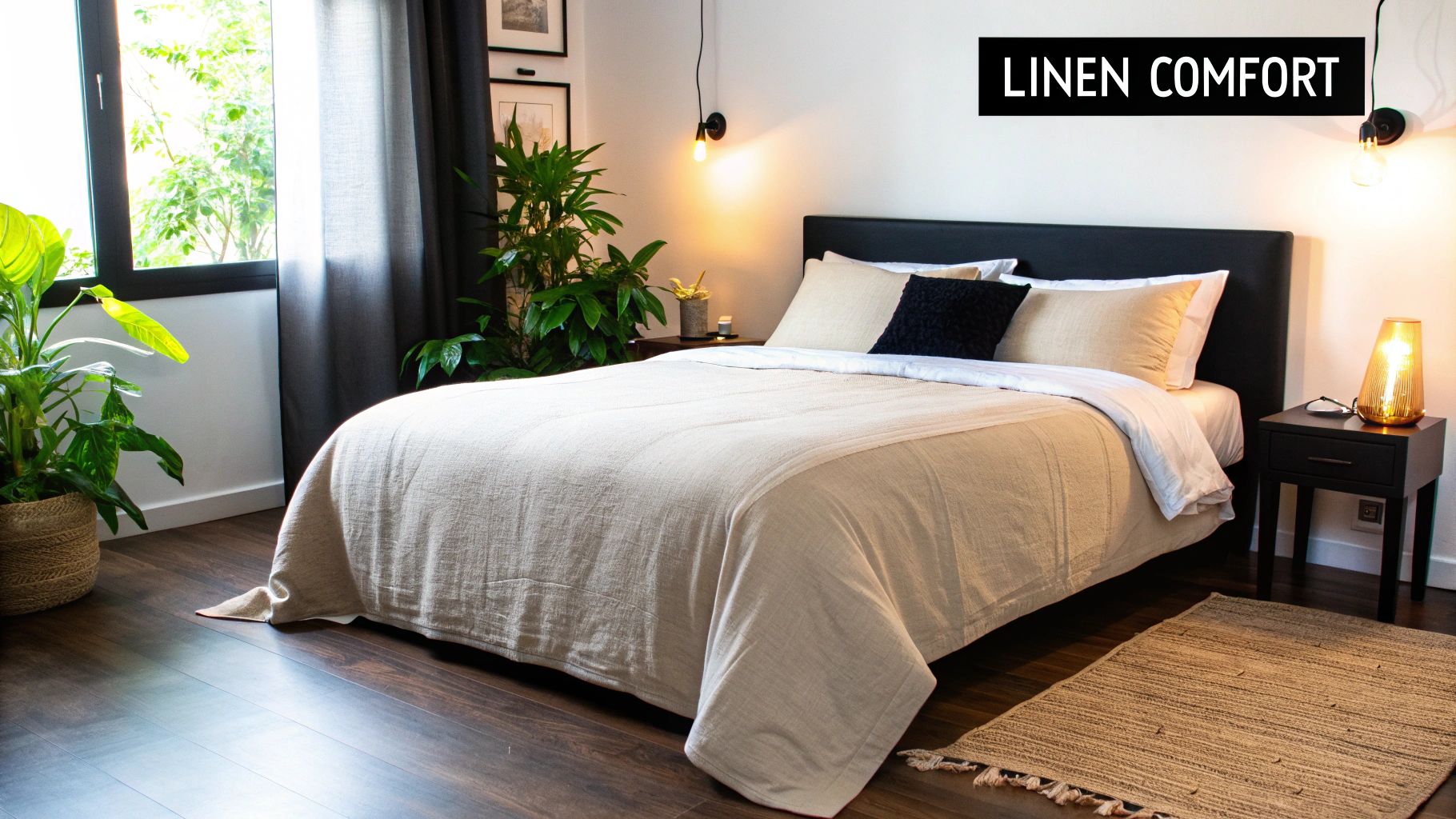
Let's dive into why linen duvet covers are fast becoming a staple in bedrooms from Northland to Southland. To really get it, we need to look at linen's journey from the humble flax plant to the beautiful textile you sleep under. It's a story that builds a real appreciation for its quality.
From Plant to Premium Fabric
Linen starts its life as the flax plant, a hardy crop that needs far less water and fewer pesticides than cotton. This makes it an incredibly sustainable choice, something that resonates with many environmentally conscious Kiwis. The long, strong fibres are harvested from the plant's stalk, then processed and spun into the textured yarn that gives linen its famous character and strength.
The real magic of linen is its transformation. What begins as a simple plant becomes a fabric that not only looks beautiful but actively improves with age, growing softer and more inviting with every single wash.
This journey from the field to your bedroom is a testament to natural craftsmanship. The end result is a fabric that not only feels amazing against your skin but is built to last, making it a truly worthwhile investment for your home.
Why Linen Suits the NZ Lifestyle
So, why is linen such a perfect match for our lifestyle here in New Zealand? Its natural properties are the key. We're seeing a real shift towards natural, high-performance textiles in Kiwi homes, and linen fits the bill perfectly.
Across the country, the demand for premium bedding is growing. Linen’s moisture-wicking and breathable qualities are exactly what people are looking for in comfortable, sustainable homewares. If you're interested, you can explore more about these market dynamics to see the trends shaping NZ homes.
This isn't just about buying a new duvet cover. It’s about choosing a product that genuinely enhances your home and your sleep. It’s an investment in:
- Lasting Comfort: Unmatched breathability keeps you cool on those warm summer nights and cosy during a winter chill.
- Effortless Style: It has a relaxed yet sophisticated look that just works with modern NZ interior design.
- A Sustainable Choice: An eco-friendly material that aligns with a more conscious way of living.
- Exceptional Durability: This is a long-term purchase that honestly gets better and better over time.
Why Linen is Perfect for the NZ Climate
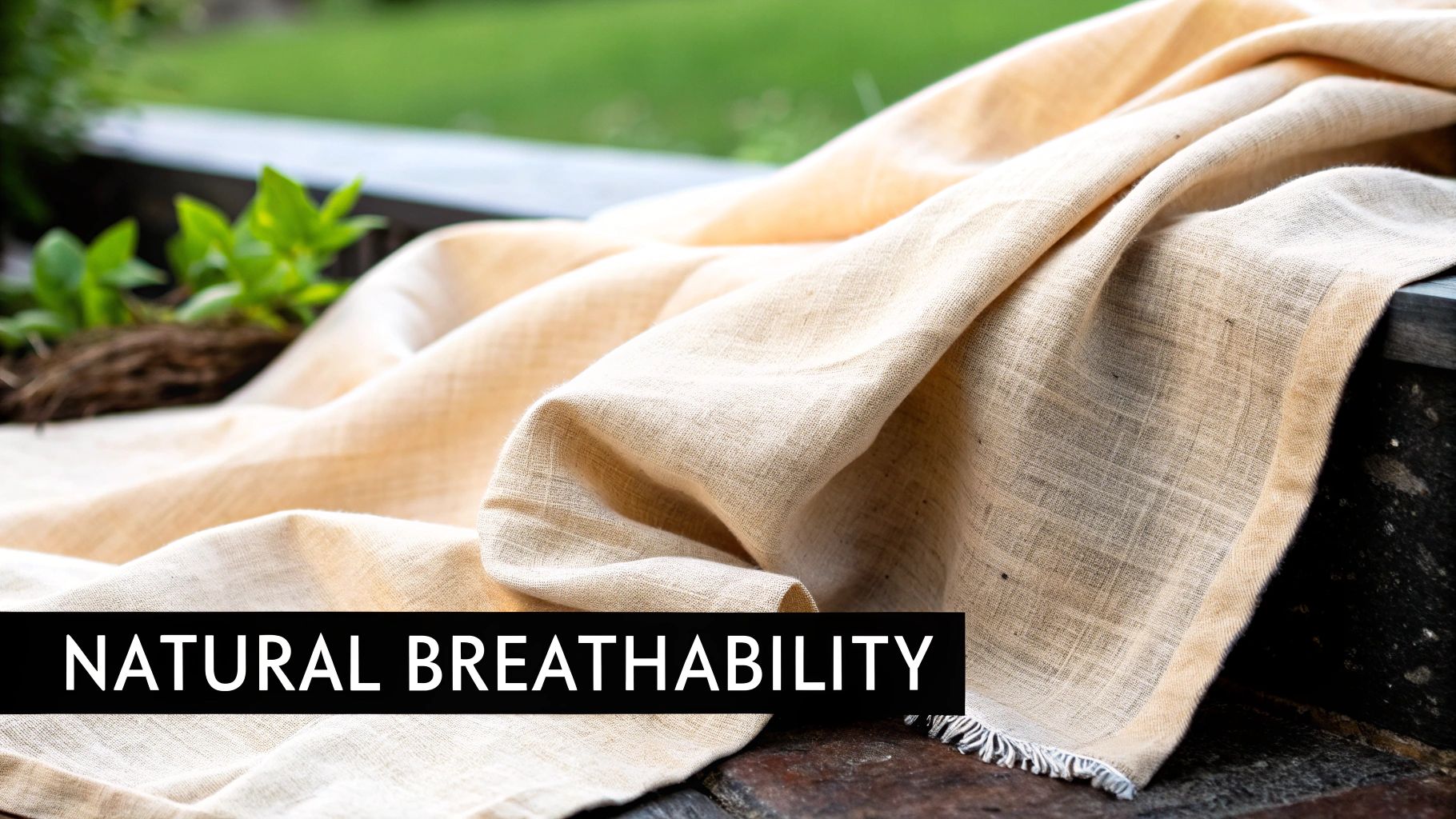
Let's talk about why linen is so much more than just a pretty fabric. It's actually a brilliantly practical choice for our famously changeable New Zealand climate. Just think about it—one duvet cover that keeps you cool during a humid Auckland summer and perfectly cosy on a frosty Queenstown winter night.
That's the real magic of linen. It's not just bedding; it's a smart, responsive material that helps you sleep better, no matter what the weather decides to do.
The Ultimate Temperature Regulator
So, what's linen's secret? It all comes down to the flax plant fibres it's made from. These fibres are actually hollow, which is a game-changer for bedding.
You can think of these microscopic hollow cores as a natural ventilation system woven right into the fabric. This unique structure lets air move freely, which is why linen feels so incredibly breathable. On a warm, sticky night, it wicks moisture away and lets your body heat escape, keeping you dry and comfortable. No more clammy sheets.
But here’s the clever part. In winter, those same hollow fibres do the opposite—they trap your own body heat, creating a snug layer of natural insulation around you. This makes a linen duvet cover in NZ a genuinely smart choice for navigating everything from four-seasons-in-one-day to the distinct climates across the country.
Linen's thermoregulating ability is its superpower. It doesn't just sit there; it actively works with your body's temperature to keep you comfortable all night long.
Incredible Durability That Gets Better with Age
When you spend good money on homewares, you want them to last. Linen is one of the strongest natural fibres in the world, renowned for its exceptional durability. While other fabrics tend to wear out, thinning and pilling with every wash, linen just gets better.
It’s true. With each wash cycle, the fibres relax and soften, making your duvet cover even more inviting than the day you bought it. You’re not just buying a product for today; you're investing in bedding that will become a treasured favourite for years, even decades. This longevity makes quality linen duvet covers NZ a truly sensible long-term decision for your home.
If you're weighing it up against other fabrics, you can dive deeper into why linen is often considered better than cotton in our detailed guide.
A Healthy and Sustainable Choice for Your Home
Beyond its comfort and strength, linen has some fantastic benefits that align perfectly with the Kiwi value of looking after ourselves and our environment.
- Naturally Hypoallergenic: Linen is inherently resistant to bacteria and microbes, making it a fantastic choice for anyone with allergies or sensitive skin. It helps create a cleaner, healthier place to sleep.
- Moisture Wicking: The fabric can absorb up to 20% of its own weight in moisture before it even starts to feel damp. This is key to preventing that clammy feeling you get with synthetics.
- Eco-Friendly Production: The flax plant is a wonderfully hardy and sustainable crop. It requires far less water and fewer pesticides to grow than cotton, which helps protect our precious waterways and soil.
Choosing linen is a conscious decision. It's for people who want products that aren't just beautiful and functional, but also kind to the planet. You’re supporting more sustainable farming and reducing your home’s environmental footprint—a choice that’s better for you and for Aotearoa.
How to Choose Your Perfect Linen Duvet Cover
Picking out the right linen duvet cover can feel like a big commitment, but it really doesn't need to be overwhelming. The goal is to feel confident in your choice, and this guide will walk you through everything you need to know to find the perfect one for your home here in New Zealand. We'll break down the important stuff and translate any confusing jargon into simple, practical advice.
Think of it like choosing the best ingredients for a favourite recipe. The quality of each part—the fabric's weight, where the flax was grown, even the type of buttons or ties—all comes together to create the final experience. By understanding these details, you can find a linen duvet that suits your style and budget perfectly, setting you up for years of incredible sleep.
Decoding Fabric Weight: GSM Explained
One of the first things you'll likely come across when shopping for linen duvet covers in NZ is GSM, which stands for "grams per square metre." It's simply a measure of the fabric's weight and density. It isn't a direct measure of quality, but it tells you a lot about how the linen will feel and hang on your bed.
It’s a bit like comparing a light summer jacket to a heavy woollen winter coat. Both are fantastic, but they’re designed for different jobs. Linen is the same:
- Lighter Linen (120-150 GSM): This linen feels incredibly airy and breathable, with a more delicate touch. It's the perfect choice for hot sleepers or for anyone wanting to create that light, floaty, coastal bach vibe so many of us love in our Kiwi homes.
- Mid-weight Linen (150-180 GSM): For many, this is the sweet spot. It strikes a beautiful balance between softness and durability, making it a fantastic year-round option that feels substantial without ever being too heavy.
- Heavier Linen (180+ GSM): This weight gives you a more luxurious, cosy, and enveloping feeling. It drapes beautifully over the bed and is exceptionally durable, making it a wonderful choice if you love a snug, comforting bed—especially in the cooler South Island climates.
When you're weighing up options, it helps to see how linen stacks up against other popular materials on the market.
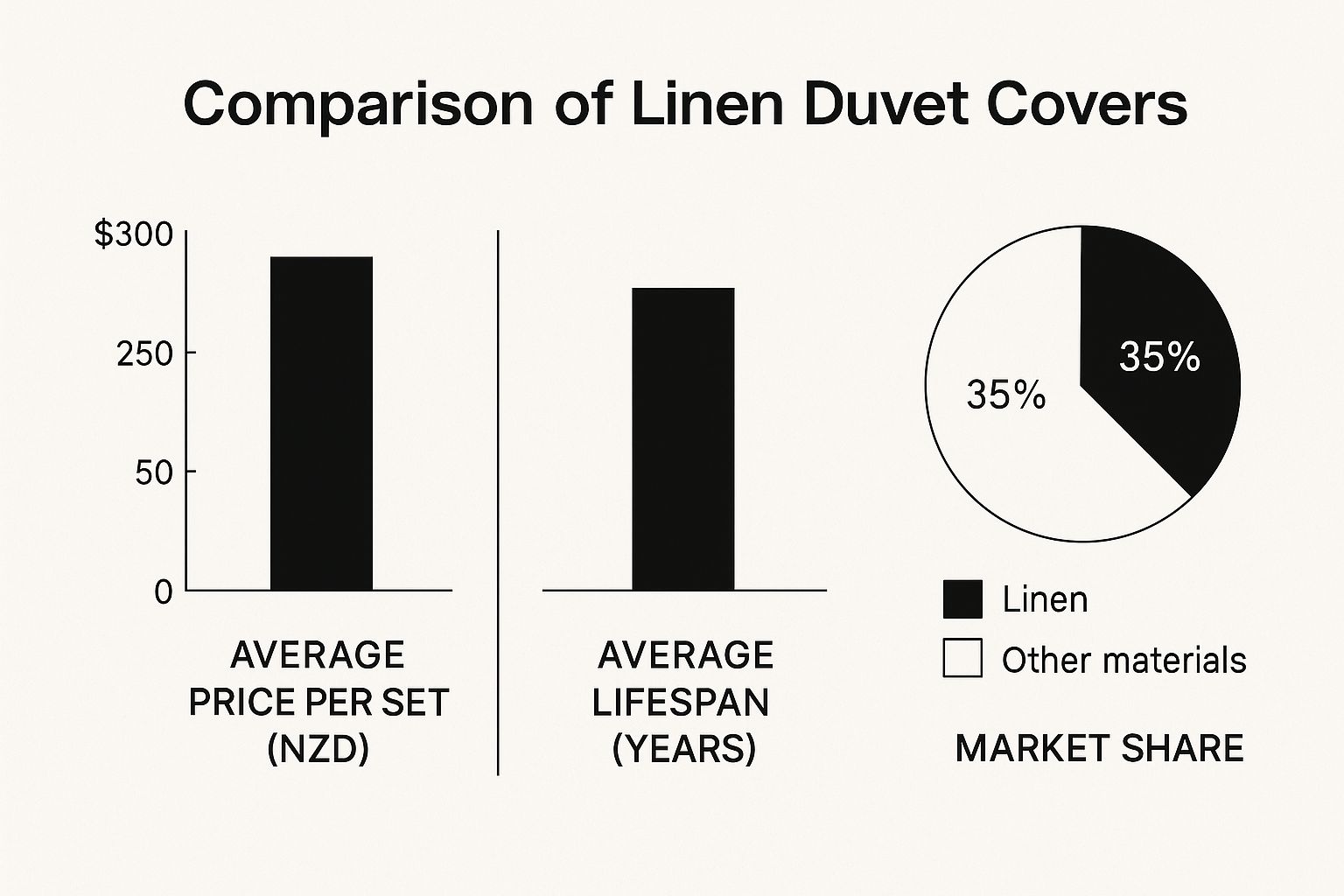
While linen might have a higher price tag upfront, its incredible lifespan makes it a far better long-term investment. It’s a classic case of buying well once.
Understanding Flax Origin and Quality
Not all linen is created equal, and where it comes from often says a lot about its quality. The world’s best linen typically starts as flax grown in Western Europe, especially in the coastal regions of France and Belgium. The unique mix of a damp climate and rich soil in this area produces exceptionally long, strong flax fibres.
When you see a label that says French Linen or Belgian Linen, you know you're looking at premium quality. These longer fibres are spun into a yarn that results in a smoother, stronger fabric that’s far less likely to shed lint than linen made from shorter fibres. Just keep in mind that while the flax might be grown in Europe, the fabric could be woven and finished somewhere else. Good brands are always transparent about their entire supply chain.
Comparing Bedding Materials for the NZ Climate
With our unique climate, choosing the right bedding material is key. This table lays out how linen compares to other common choices.
| Feature | Linen | Egyptian Cotton | Bamboo Viscose |
|---|---|---|---|
| Breathability | Excellent. Keeps you cool in summer, warm in winter. Perfect for NZ's variable weather. | Good, but can trap heat more than linen. | Very good, but can feel clammy in high humidity. |
| Durability | Outstanding. Gets softer with every wash and can last for decades. A true investment. | Strong, but can wear out faster than linen, especially in high-friction areas. | Less durable. Prone to pilling and can lose its shape over time. |
| Feel & Texture | Naturally textured, relaxed, and becomes incredibly soft over time. | Smooth and crisp, often with a slight sheen when new. | Silky smooth and very soft, but can feel slippery to some. |
| Moisture Wicking | Superior. Absorbs moisture without feeling damp, ideal for humid nights. | Absorbs moisture well, but can feel damp and take longer to dry. | Wicks moisture, but can feel heavy when it absorbs a lot of sweat. |
| Eco-Friendliness | Highly sustainable. Flax requires little water or pesticides and is biodegradable. | Requires significant water and pesticides, though organic options are better. | Manufacturing process can be chemically intensive and not very eco-friendly. |
Ultimately, while cotton and bamboo have their place, linen's combination of durability, breathability, and sustainability makes it an unbeatable choice for the New Zealand lifestyle.
Navigating NZ Bedding Sizes
This one might sound obvious, but you’d be surprised how many people skip this step: always check the measurements of your duvet inner. New Zealand has standard bedding sizes, but it always pays to measure twice and buy once. A duvet cover that's too big will look sad and saggy, and one that's too small will make the inner bunch up uncomfortably.
A perfect fit is crucial, especially as consumer tastes are shifting. For years, cotton was the default choice, but its market has seen a massive downturn recently. In fact, the market for cotton bed linen in New Zealand plummeted to about $3.8 million, a staggering 96.9% drop from the year before. This huge shift has opened the door for high-quality alternatives like linen to meet the demand for lasting, comfortable bedding. You can discover more insights about the NZ bed linen market to see the trends for yourself.
Always double-check the dimensions on the product page against your duvet inner. A perfect fit is what makes a bed look and feel amazing.
Choosing the Right Closure Style
The last little detail to think about is how your duvet cover closes. This usually comes down to personal taste, as each style has its own look and feel.
- Button Closures: These are a classic for a reason. Often hidden for a clean, seamless look, buttons provide a really secure closure that stops the duvet inner from sneaking out.
- Tie Closures: Simple fabric ties give your bed a relaxed, rustic, and slightly bohemian vibe. They're easy to use and add a lovely, handcrafted detail to your bedding.
- Zipper Closures: A modern and super practical choice. Zippers make changing the duvet cover quick and painless. Just be sure to look for a high-quality, concealed zip that won’t snag or break.
By keeping these key points in mind—GSM, flax origin, sizing, and closures—you’ll have all the knowledge you need to choose a linen duvet cover in NZ that you’ll absolutely love for years.
Styling Your Bedroom with Linen
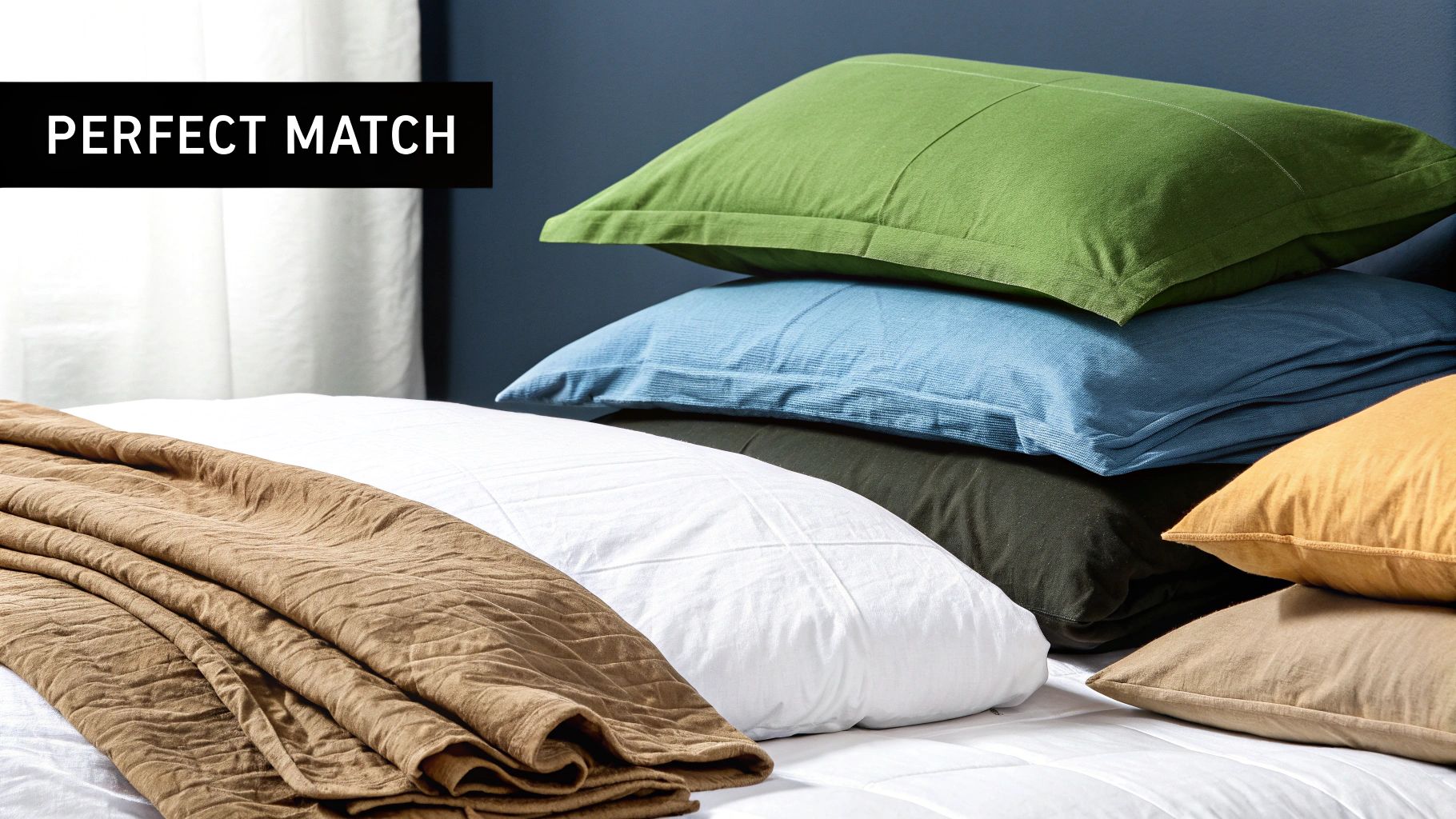
A beautiful linen duvet cover is so much more than just bedding; it's the very foundation of your bedroom's design. With its unique texture and elegant drape, linen has a special ability to anchor the entire space, making it surprisingly easy to create a personal sanctuary that feels both stylish and incredibly welcoming.
What I love most about linen is its sheer versatility. It slips effortlessly into the diverse interior styles we see across New Zealand, from a classic, laid-back coastal bach to a sleek, sophisticated urban apartment. Here are a few creative and totally achievable ideas to help you style a linen duvet cover in NZ and turn your bedroom into a place you genuinely love spending time in.
Embracing the Relaxed Coastal Aesthetic
Ah, the quintessential Kiwi bach look. It’s all about capturing that feeling of calm, breezy, and completely effortless living. Linen is the perfect fabric for this, bringing a natural, textural element that feels deeply connected to our coastal landscape.
To get this look right, start with a base of soft, neutral colours that echo the world just outside your window:
- Soft Whites & Off-Whites: These create a light, airy foundation that feels clean and refreshing, like a perfect summer's day.
- Sandy Beiges & Warm Greys: Think sun-drenched sand and weathered driftwood. These tones bring a lovely warmth and sense of being grounded.
- Subtle Blues & Greens: Gentle shades of seafoam, duck egg blue, or pale sage can introduce a hint of coastal colour without disturbing the serene atmosphere.
The real trick to this style is keeping things simple. Don't overdo it. Just let the beautiful, natural texture of your linen duvet cover be the star of the show.
Creating a Sophisticated Urban Look
Don't be mistaken—linen isn't just for casual, coastal vibes. It can also be the centrepiece of a chic, modern bedroom with a much more sophisticated, even moody, feel. For this urban aesthetic, the focus shifts to richer colours and more deliberate, thoughtful layering.
Try using deeper, earthier tones to create a real sense of warmth and intimacy. Colours like a deep charcoal, rich terracotta, olive green, or even a moody amber can transform your linen bedding into a luxurious statement piece. These darker shades highlight linen’s subtle texture in a whole new way, adding incredible depth and character to the room.
To really elevate the urban look, contrast is your best friend. Try pairing a dark linen duvet cover with crisp white pillowcases, or layer it with a throw in a complementary but distinct colour. This simple trick creates a visually interesting and polished design.
This approach really proves that a linen duvet cover is a true style chameleon, capable of adapting to a refined, contemporary setting just as easily as a relaxed one.
The Art of Layering Textures
One of the most powerful secrets to creating a bedroom that feels professionally styled and genuinely inviting is the artful layering of different textures. This is where linen truly shines. Its natural, slightly rumpled surface provides the perfect canvas to build upon.
Layering adds visual weight, warmth, and a tactile richness that makes a room feel finished and whole.
Think of your linen duvet as the starting point. From there, you can add various elements to build up that delicious depth:
- Chunky Wool Throws: A thick, knitted wool blanket draped across the end of the bed adds instant cosiness and a wonderful contrast to the lighter texture of the linen.
- Velvet Cushions: For a touch of pure luxury, introduce a few velvet cushions. Their soft, plush surface plays beautifully against linen’s more rustic feel.
- Rustic Timber Furniture: Placing your linen-dressed bed next to a timber bedside table or headboard creates a fantastic blend of soft and hard textures, grounding the space with natural materials.
Mixing these materials is what stops a room from feeling flat or one-dimensional. It’s a simple technique that designers use all the time to create spaces that feel both curated and comfortable—and it makes you want to reach out and touch everything. It’s this thoughtful combination that turns a simple bedroom into a true retreat.
A Simple Care Guide for Lasting Linen
When you invest in a beautiful linen duvet cover, you want it to last. The good news is, it’s much simpler than you might think. With just a little know-how, your linen won’t just last for years, it will actually get better with age, becoming an even more cherished part of your home. It’s all about working with the fabric's natural qualities, not against them.
This guide is all about straightforward, easy-to-follow advice to keep your linen looking and feeling its best. We'll cover everything from that important first wash to daily care, so you can truly embrace the effortless elegance of linen. Let’s say goodbye to complicated laundry days and hello to a simpler, more beautiful way of living.
The Crucial First Wash
Before you even think about dressing your bed with your new linen, giving it a wash is a must. This first wash is what kicks off the famous softening process linen is known for. It helps relax the fibres and washes away anything left over from the manufacturing process.
For this first wash—and all the ones that follow—a gentle touch is key. Use a mild, liquid detergent and give fabric softeners a miss. They can coat the natural fibres, which actually reduces their wonderful breathability. A gentle cycle with cool or lukewarm water (around 30°C) is all it takes to clean your linen perfectly without putting any stress on the fabric.
Think of this first wash as an introduction. You're gently waking up the linen fibres, encouraging them to relax and begin their journey to becoming incredibly soft and supple. It sets the stage for years of comfort.
Best Practices for Machine Washing
Caring for your linen duvet cover is refreshingly low-maintenance. The main thing to remember is to be gentle. A common mistake is cramming too much into the washing machine; always give your duvet cover plenty of room to move around. This not only gives it a better clean but also helps prevent it from getting too creased.
It's also a good idea to wash it with similar colours and fabrics. Avoid throwing your beautiful linen in with heavy items like towels or denim, as they can be too abrasive and cause friction or pilling. A simple, gentle cycle is all it needs.
The Art of Drying Your Linen
How you dry your linen makes a huge difference to how it looks and feels. Hands down, the best way to do it is to line dry. Hanging your duvet cover outside in the fresh New Zealand air lets it dry naturally, leaving it feeling crisp yet soft and smelling absolutely wonderful. Just give it a firm shake before you hang it out to help release any big wrinkles.
If you have to use a tumble dryer, the golden rule is low and slow. Use a low heat setting and, this is the important bit, pull it out while it’s still slightly damp.
- Avoid Over-drying: This is the number one cause of stiffness and deep-set wrinkles in linen.
- Embrace the Texture: Taking it out while still a little damp and putting it straight on the bed lets it finish drying flat. This is the secret to achieving that signature relaxed, rumpled look.
That one simple step is how you get that effortlessly chic style without ever needing to touch an iron. For a deeper dive, you can check out our complete linen care guide, which covers everything you need to know.
Handling Stains and Daily Care
Life happens, and so do spills. The great thing about linen is its resilience. For most little accidents, acting quickly is your best bet. Gently blot the stain with a clean, damp cloth—never rub, as that can just push the stain deeper into the fibres. For more stubborn marks, a gentle spot treatment with a mild stain remover before washing usually does the trick.
With premium bedding becoming more of a considered purchase, proper care is what ensures you get your money's worth. Interestingly, the overall bed linen market in New Zealand has seen a major contraction, shrinking by approximately 93.1% to a sales value near $10 million recently. This sharp drop might point to a shift in how we shop—perhaps moving towards higher-quality, longer-lasting items like linen that justify a more mindful care routine.
Forget the Iron, Embrace the Wrinkles
Honestly, this is the best piece of advice you’ll get: put your iron away. One of the most beautiful things about linen is its natural, slightly crumpled texture. It’s a huge part of its charm and what gives it that relaxed, lived-in feeling. Trying to fight it is a losing battle and completely misses the point.
By following these simple care steps—gentle washing, mindful drying, and embracing its natural state—your linen duvet cover will reward you for years. It will only get softer and more beautiful, becoming a unique piece that is truly yours.
Common Questions About Linen Duvet Covers
When you’re thinking about investing in your bedding, it’s completely natural to have questions. Making the switch to a linen duvet cover in NZ is a decision that promises better sleep and a more beautiful bedroom, but you want to be sure it’s the right move for you.
To help you feel confident, we’ve put together the most common questions Kiwis ask about linen bedding, along with the clear, straightforward answers you need.
Is Linen Worth the Higher Price Tag in NZ?
Absolutely. While a linen duvet cover might have a higher upfront cost than cotton or synthetic options, it’s a classic case of long-term value over a short-term price tag. Think of it less as a purchase and more as an investment in your home and your wellbeing.
A huge part of this is linen's incredible durability. It's made from one of the strongest natural fibres on the planet, meaning a quality linen duvet cover is built to last for decades, not just a few seasons. Unlike other fabrics that wear thin, pill, or lose their shape, linen actually gets better with age, growing softer and more beautiful with every wash.
When you break down the cost over its lifespan, linen often ends up being the more economical choice. You're paying for years of incredible comfort, timeless style, and a healthier sleep environment—value that easily outweighs the initial price.
Plus, its ability to perform year-round in our unique New Zealand climate means you don't need separate summer and winter duvets. That kind of versatility adds another layer of practical value, making it a truly smart choice for any Kiwi home.
Will a New Linen Duvet Cover Feel Scratchy?
This is a really common concern, but it’s mostly a myth that comes from bad experiences with low-quality linen. A high-quality, pre-washed linen duvet cover should feel soft and comfortable from the very first night. Any initial crispness is just a sign of the fabric’s natural texture, and it quickly settles into a supple, gentle feel.
The real magic of linen is how it transforms over time. It gets noticeably softer, smoother, and more inviting with every single wash cycle—a journey that other fabrics just can’t replicate.
Many top NZ brands use a special process called stone-washing to kick-start this softening. The technique involves washing the fabric with large stones to gently pummel the fibres, giving you that perfectly relaxed, day-one softness that linen lovers are after. If you’ve felt linen that was coarse or scratchy, it was likely made from lower-grade, shorter flax fibres or hadn’t been finished properly. To really get a feel for its unique qualities, we recommend exploring the inherent luxury of linen sheets in our detailed guide.
How Do I Stop My Linen from Wrinkling?
The short answer is: you don’t! Embracing that relaxed, slightly rumpled look is a huge part of linen’s effortless charm. That beautiful, natural texture is what gives a bedroom its inviting, lived-in feel. If you try to make it perfectly crisp and flat like a hotel bed, you’re kind of missing the point of what makes linen so special.
That said, you can easily manage the wrinkles so your bed looks stylishly relaxed rather than just messy. The key is to avoid over-drying, as high heat is what sets in those deep, stubborn creases.
Here are a few simple tricks to keep heavy wrinkling at bay:
- Pull it out early: Take your duvet cover out of the washer or dryer while it’s still slightly damp.
- Give it a good shake: A firm shake before you hang it on the line or put it on the bed works wonders to release the worst of the creases.
- Let it finish on the bed: Putting the slightly damp cover straight onto your duvet inner lets it dry flat, leaving you with that perfect, soft, rumpled look.
If you absolutely must have a tidier finish, a quick pass with an iron on a medium-hot setting while the fabric is still damp will do the trick. But for most of us, learning to love the texture is a far simpler approach.
Where Can I Find the Best Linen Duvet Covers in NZ?
New Zealand has a fantastic and growing range of retailers offering beautiful, high-quality linen bedding. You no longer have to look far to find world-class options designed with Kiwi homes in mind.
You can shop directly from specialised local NZ brands online, browse high-end homeware stores, or check out the bedding departments of major retailers. When you’re comparing your options, look for brands that are open and honest about where their linen comes from and how it’s made.
A few key things to look for include:
- Flax Origin: The best brands will proudly state if their linen is made from premium European flax, such as French or Belgian flax.
- Customer Reviews: See what other Kiwis are saying about the softness, durability, and overall experience.
- Clear Product Details: Look for information on fabric weight (GSM) and whether it has been finished with processes like stone-washing.
Shopping with a trusted local brand often means you get a product thoughtfully designed for our lifestyle, plus you get excellent service and support. It’s the best way to ensure you’re investing in a piece that will truly elevate your home.
Ready to experience the unmatched comfort and timeless style of pure linen? At The Foxes Den, we offer a curated collection of luxurious, 100% European flax linen bedding designed to transform your bedroom into a sanctuary. Explore our collection of linen duvet covers today.


